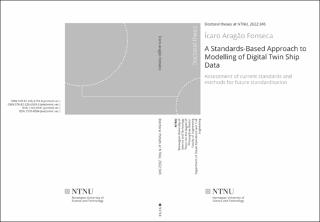| dc.contributor.advisor | Gaspar, Henrique | |
| dc.contributor.advisor | Hildre, Hans Petter | |
| dc.contributor.author | Fonseca, Ícaro Aragao | |
| dc.date.accessioned | 2022-12-02T08:36:44Z | |
| dc.date.available | 2022-12-02T08:36:44Z | |
| dc.date.issued | 2022 | |
| dc.identifier.isbn | 978-82-326-6569-3 | |
| dc.identifier.issn | 2703-8084 | |
| dc.identifier.uri | https://hdl.handle.net/11250/3035546 | |
| dc.description.abstract | The popularisation of sensors, internet of things, and data analysis tools is bringing opportunities for several industries to improve their products and processes. One of the concepts making use of such opportunities is the digital twin, a comprehensive simulation of an engineering system that receives updated data from that system to mirror and predict its behaviour. In the ship domain, development of comprehensive digital twins finds obstacles in the lack of interoperability among digital tools and their formats. This thesis investigates use of standards to model digital twin ships with the aim of enabling data exchanges among systems, i.e., a standards-based approach.
The work begins by investigating challenges to digital twin standardisation from the perspective of previous initiatives in the ship industry, comparisons with other sectors, and emerging trends. A few drivers are identified to guide future standardisation attempts: pragmatism in scope, support to heterogeneous systems, openness, and intelligibility. Following from these drivers, the study identifies existing standards covering the domains of ship visualisation, sensor logs, and taxonomies for ship data. They are applied to develop a web-based digital twin of an experiment in a wave basin, taking advantage of the broad support offered to web standards. The case study delimits standardisation gaps in the domains of ship models, with its accompanying metadata, and simulation of ship behaviour in operation. Both of them are taken as motivation for following research stages. The first topic is addressed by extending the open source Vessel.js library, originally developed for conceptual ship design, to handle detailed vessel models suitable for digital twins. This is done with a flexible framework which allows mapping of digital twin data to existing ship taxonomies during both design and operation. The framework is applied to a case study with a research vessel, demonstrating advantages and uncovering obstacles to scaling. The second topic is partially handled through development of functionalities for simulation and visualisation of wave motion response in Vessel.js. The library is used to develop several responsive, real-time applications combining simpler models executed on the browser and results from complex analyses, executed with external software.
The work contributed to digital twin ship interoperability in two manners: by demonstrating the current state of standardisation and introducing novel methods to inform future initiatives. Given the digital twin’s ambitious scope, the latter leaves open topics for further research, such as effective simulation-based decision-support during ship operations, accounting for interaction with sensor streams in real-time. | en_US |
| dc.language.iso | eng | en_US |
| dc.publisher | NTNU | en_US |
| dc.relation.ispartofseries | Doctoral theses at NTNU;2022:345 | |
| dc.relation.haspart | Paper 1: Fonseca, Icaro Aragao; Gaspar, Henrique Murilo. Challenges when creating a cohesive digital twin ship: a data modelling perspective. Ship Technology Research 2021 ;Volum 68.(2) s. 70-83 https://doi.org/10.1080/09377255.2020.1815140 This is an Open Access article distributed under the terms of the Creative Commons Attribution-NonCommercial-NoDerivatives License (CC BY-NC-ND 4.0) (http://creativecommons.org/licenses/by-nc-nd/4.0/) | en_US |
| dc.relation.haspart | Paper 2: Fonseca, Icaro Aragao; Gaspar, Henrique Murilo; Pedro Cardozo, de Mello; Sasaki, Humberto. A Standards-Based Digital Twin of an Experiment with a Scale Model Ship. Computer-Aided Design 2022 ;Volum 145. https://doi.org/10.1016/j.cad.2021.103191 This is an open access article under the CC BY license (http://creativecommons.org/licenses/by/4.0/). | en_US |
| dc.relation.haspart | Paper 3:
Fonseca, Icaro Aragao; Gaspar, Henrique Murilo.
AN OPEN FRAMEWORK FOR DATA TAXONOMIES IN DIGITAL TWIN SHIPS | en_US |
| dc.relation.haspart | Paper 4: Escamilla i Miquel, Sergi; Fonseca, Icaro Aragao; Gaspar, Henrique Murilo; Vieira, Daniel. An open-source library for hydrodynamic simulation of marine structures. Marine Systems & Ocean Technology 2020 ;Volum 15. s. 160-174
https://doi.org/10.1007/s40868-020-00083-3
This article is licensed under a Creative Commons Attribution 4.0 International License (CC BY 4.0) | en_US |
| dc.relation.haspart | Paper 5: Fonseca, Icaro Aragao; Ferrari de Oliveira, Felipe; Gaspar, Henrique Murilo. Virtual Prototyping and Simulation of Multibody Marine Operations Using Web-Based Technologies. I: ASME 2019 38th International Conference on Ocean, Offshore and Arctic Engineering. Volume 7A: Ocean Engineering. The American Society of Mechanical Engineers (ASME) 2019 Paper No: OMAE2019-96051, V07AT06A011 s. 1-10 https://doi.org/10.1115/OMAE2019-96051 | en_US |
| dc.rights | Figure 4.7 and 4.8 from ISO 19848:2018 - Ships and marine technology - Standard data for shipboard machinery and equipment are reproduced by Ícaro Aragão Fonseca in the thesis 'A Standards-Based Approach to Modelling of Digital Twin Ship Data' under licence from Standard Online AS December 2022. © All rights are reserved. Standard Online AS makes no guarantees or warranties as to the correctness of the reproduction. In any case of dispute, the Norwegian original shall be taken as authoritative. See www.standard.no | |
| dc.title | A Standards-Based Approach to Modelling of Digital Twin Ship Data - Assessment of current standards and methods for future standardisation | en_US |
| dc.type | Doctoral thesis | en_US |
| dc.subject.nsi | VDP::Technology: 500::Marine technology: 580::Ship technology: 582 | en_US |

